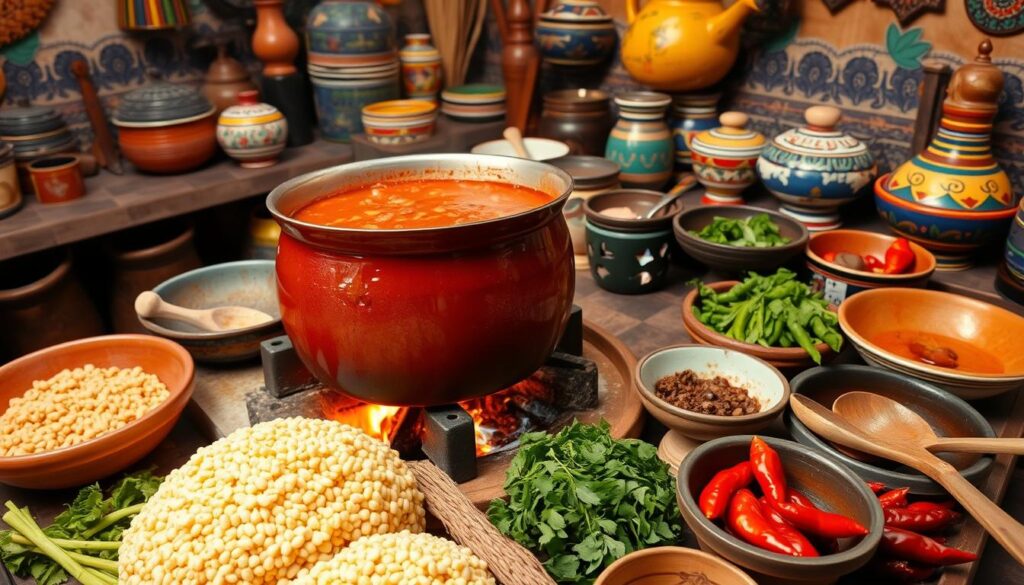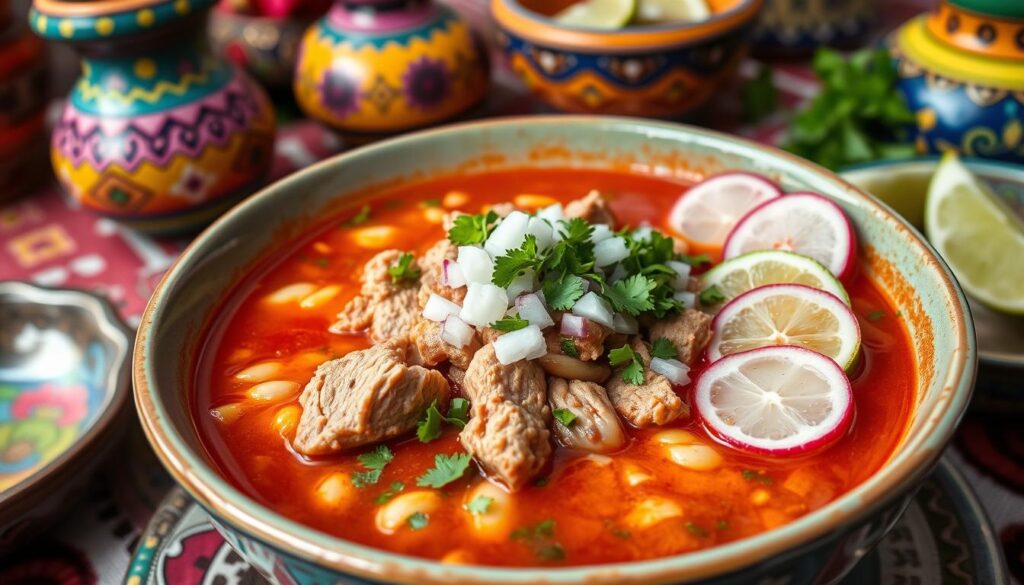Explore the true taste of Mexico with pozole rojo, a hearty hominy stew. It’s filled with tender pork, aromatic spices, and a rich red sauce. This stew will take you straight to Mexico’s heart.
Pozole rojo is more than food; it’s a celebration of family and tradition. It’s perfect for holidays or weekend meals. Its rich flavors and cultural importance will wow your guests.
- Key Takeaways
- Origins in Aztec Cuisine
- Regional Variations Across Mexico
- Traditional Holiday Significance
- Essential Spices and Aromatics
- Choosing Between Guajillo and Ancho Chiles
- Proper Chile Toasting Techniques
- Creating the Perfect Chile Sauce
- Building Layers of Flavor
- Achieving the Perfect Consistency
- Fresh Vegetable Accompaniments
- Herbs and Condiments
- Serving Suggestions
- Refrigeration Strategies
- Freezing Instructions
- Reheating Techniques
- What is pozole rojo?
- What are the key ingredients in pozole rojo?
- How long does it take to prepare pozole rojo?
- What are traditional garnishes for pozole rojo?
- Can pozole rojo be made with a different meat?
- How should I store leftover pozole rojo?
- What's the difference between white, green, and red pozole?
- Is pozole rojo spicy?
Key Takeaways
- Pozole rojo is a traditional Mexican stew with deep cultural roots
- The dish features tender pork, hominy, and a signature red sauce
- Typically served during holidays and special occasions
- Offers versatile garnishing options with fresh vegetables
- Can be prepared using various cooking methods, including stovetop and slow cooker
Understanding Mexican Pozole History and Traditions
Explore the rich history of pozole, a dish loved by many. It shows the heart of Mexican cuisine. This traditional stew has deep roots in Aztec food traditions, lasting for centuries.
The word “pozolli” comes from the Nahuatl language, showing its origins. It was once a special meal for Aztec elites. They enjoyed it during important ceremonies that celebrated harvests and divine connections.
Origins in Aztec Cuisine
In ancient times, pozole was very important. The Aztecs made it for big festivals like Atlcahualo, honoring Tláloc, the rain god. Here are some interesting facts about its making:
- Originally made with sacred ingredients
- Linked to rituals for agricultural fertility
- Used white cacahuazintle corn as a key ingredient
Regional Variations Across Mexico
Mexican cuisine loves to show off pozole’s variety. Each area has its own special way of making this dish:
| Region | Pozole Variation | Distinctive Characteristics |
|---|---|---|
| Jalisco | Pozole Rojo | Spicy, uses guajillo chilies |
| Guerrero | Pozole Verde | Green chile-based version |
| Michoacán | Traditional White Pozole | Lighter, more subtle flavors |
Traditional Holiday Significance
Pozole is more than just food; it’s a symbol of cultural celebrations. You’ll see it on tables during big Mexican holidays like Independence Day, Christmas Eve, and New Year’s Eve. It brings people together, showing our shared heritage and love for food.
Pozole is not just a meal; it’s a bridge to Mexico’s rich cultural story.
Essential Ingredients for Authentic Pozole Rojo
Making authentic pozole rojo starts with picking the right ingredients. This traditional Mexican stew needs a mix of parts that add depth and rich flavor to each bowl.
The core of pozole rojo includes several key ingredients. They turn a simple soup into a true culinary work of art:
- Pork shoulder: A well-marbled cut that adds incredible richness
- Hominy: The signature corn kernel that gives pozole its unique texture
- Dried chiles: Guajillo and ancho chiles make the signature red color and complex flavor
“Authentic pozole is about balancing flavors and honoring traditional ingredients”
When choosing your pork shoulder, pick meat with good marbling for the best flavor. For hominy, dried options can make your dish more authentic than canned.
The dried chiles are key for the red sauce. Guajillo chiles add a mild, tangy heat. Ancho chiles bring a deeper, slightly sweet flavor.
Essential Spices and Aromatics
To finish your pozole rojo, you’ll need these important seasonings:
- Mexican oregano
- Cumin
- Garlic
- Onion
These ingredients together make a deeply satisfying and authentic Mexican stew. It will take your taste buds straight to traditional Mexican kitchens.
The Art of Selecting and Preparing Dried Chiles
Dried chiles are key to making real Mexican dishes, like pozole rojo. Learning how to pick, toast, and prepare them can make your cooking amazing.
Dried chiles come in many flavors and heat levels. Before making chile sauce, it’s important to know about different chile types.
Choosing Between Guajillo and Ancho Chiles
For pozole, two chiles are best known:
- Guajillo Chiles: Sweet, smoky with a fruity taste
- Scoville Rating: 2,000 – 5,000
- Great for making deep, complex chile sauce
- Ancho Chiles: Mild, sweet-smoky taste
- Scoville Rating: 500-3,000
- Brings depth without too much heat
Proper Chile Toasting Techniques
Toasting chiles brings out their best flavor. Here’s how to do it right:
- Use a dry skillet over medium heat
- Toast chiles for 20-30 seconds on each side
- Look for color change and smell
- Don’t let them burn – that’s bitter
Creating the Perfect Chile Sauce
Your chile sauce is the heart of pozole rojo. Here’s how to make a true sauce:
| Step | Action | Duration |
|---|---|---|
| 1. Toast Chiles | Dry roast guajillo and ancho chiles | 30-45 seconds |
| 2. Soak | Cover toasted chiles in hot water | 15-20 minutes |
| 3. Blend | Combine with garlic, onion, spices | 2-3 minutes |
Pro tip: Remove seeds and veins to control the heat level of your chile sauce.
“Dried chiles are not just ingredients; they’re a culinary passport to Mexico’s rich gastronomic heritage.” – Mexican Culinary Expert
Preparing the Pork and Hominy Base
To make the best pozole rojo, start with a top-notch pork shoulder. This cut is tender and full of flavor, making it the heart of your stew. Opt for a bone-in pork shoulder, about 4 pounds, for the best taste.
- Cut the pork into large, manageable chunks
- Season generously with kosher salt
- Brown the meat in batches to develop deep flavor
- Add aromatic ingredients like:
- 6 garlic cloves
- 3 bay leaves
- Whole onion
Hominy is key to authentic pozole rojo. Use two 25-ounce cans of white hominy, drained and rinsed. Pro tip: Blanch your hominy in boiling water before adding to the stew to reduce any potential aftertaste.
“The magic of pozole lies in the slow cooking that transforms simple ingredients into a profound culinary experience.” – Traditional Mexican Cook
Your meat broth is the dish’s liquid foundation. Use about 5-6 cups of water, making sure the pork is covered by 2 inches. Simmer the pork shoulder gently – either on the stovetop for about 90 minutes or in a preheated oven at 350°F until the meat becomes fork-tender.
| Ingredient | Quantity | Preparation |
|---|---|---|
| Pork Shoulder | 4 pounds | Cut into chunks, browned |
| Hominy | 2 (25-oz) cans | Drained, rinsed, blanched |
| Water | 5-6 cups | Cover meat by 2 inches |
Remember, patience is key when preparing the pork and hominy base. Your careful preparation will result in a rich, deeply satisfying pozole rojo that captures the essence of traditional Mexican cuisine.
Pozole Rojo: Creating the Signature Red Broth
Making the perfect red sauce for pozole is all about balance and skill. The core of this Mexican dish is its rich, complex broth. It turns simple ingredients into a true masterpiece.
The secret to pozole rojo is blending different chiles for a vibrant red sauce. It’s about mixing ingredients in a way that adds depth.
Building Layers of Flavor
To make a real pozole broth, follow these steps:
- Toast dried guajillo and California chiles to release their intense flavors
- Blend chiles into a smooth, rich sauce
- Incorporate chicken bouillon for additional depth
- Simmer pork bones to extract maximum flavor
Achieving the Perfect Consistency
The perfect pozole broth is robust but not too thick. You need to mix the meat broth with the red sauce just right. This creates a beautiful coat on every ingredient.
“A great pozole is about patience and understanding how flavors develop over time.” – Traditional Mexican Chef
Pro tip: Use about 3 tablespoons of chicken bouillon and 5 different chiles for that deep pozole flavor. Your goal is a broth that tells a story of Mexican culinary tradition with every spoonful.
Traditional Cooking Methods and Timing
Making authentic pozole rojo is all about patience and slow cooking. It turns simple ingredients into a rich, complex dish. This Mexican stew’s deep flavors come from careful simmering and long cooking times.

There are different ways to cook pozole rojo, but they all focus on slow cooking and simmering:
- Stovetop Method: 2-3 hours total cooking time
- Slow Cooker: 6-8 hours on low setting
- Instant Pot: Approximately 40 minutes under pressure
The secret to great pozole rojo is knowing how to cook it right. Simmering makes the pork tender and the broth rich and complex.
| Cooking Method | Total Cooking Time | Meat Tenderness |
|---|---|---|
| Traditional Stovetop | 2-3 hours | Very Tender |
| Slow Cooker | 6-8 hours | Extremely Tender |
| Instant Pot | 40 minutes | Tender |
“The magic of pozole is in its slow transformation, where time becomes the most important ingredient.” – Mexican Cooking Tradition
When making pozole rojo, remember that patience is key. Whether you use stovetop, slow cooker, or Instant Pot, the goal is the same. You want tender meat and a rich broth that shows off traditional Mexican flavors.
Essential Garnishes and Toppings
Turning your pozole into a masterpiece is all about the garnishes and toppings. These add not just looks but also flavor. Choose wisely to elevate your dish.
Fresh Vegetable Accompaniments
The right garnishes can make your pozole unforgettable. Fresh veggies are key to a balanced, exciting meal. Here are the top fresh vegetable toppings:
- Thinly sliced radishes (approximately 20-30 slices)
- Shredded romaine lettuce (5-6 cups)
- Diced white onion (1/2 cup)
Herbs and Condiments
Herbs and toppings can turn your pozole into a true Mexican feast. Here are some classic garnishes:
- Chopped fresh cilantro
- Lime wedges (5-6 limes)
- Crumbled queso fresco
- Diced avocado
- Crispy tortilla strips
“The magic of pozole lies in its garnishes – each bite tells a story of tradition and flavor.”
Set your garnishes on a platter for diners to customize. The mix of fresh vegetables, herbs, and condiments makes each bowl unique.
| Garnish | Quantity per Serving | Flavor Profile |
|---|---|---|
| Radishes | 3-4 slices | Crisp, peppery |
| Lime Wedges | 1-2 wedges | Acidic, bright |
| Chopped Onion | 2 tablespoons | Sharp, fresh |
| Cilantro | 1 tablespoon | Herbal, citrusy |
The best pozole is yours to make. Try different toppings to find your favorite mix!
Serving and Presentation Tips
Creating an authentic presentation for pozole rojo turns your meal into a true culinary experience. The key is to pick the right bowls and arrange garnishes wisely.
For the best presentation, choose large, deep ceramic bowls. They should hold the rich broth and generous toppings well. Traditional Mexican pottery adds a vibrant cultural touch to your meal.
Serving Suggestions
- Use wide, deep bowls (at least 12-16 ounces)
- Serve warm corn tortillas or crispy tostadas on the side
- Arrange garnishes in separate small bowls for customization
Your serving presentation should include fresh toppings for guests to customize their pozole. Set up a garnish station with these items:
- Finely chopped white onion
- Fresh lime wedges
- Sliced radishes
- Shredded cabbage
- Chopped cilantro
- Sliced avocado
“A beautifully presented pozole is not just a meal, but a celebration of Mexican culinary tradition.”
For an extra special touch, serve your pozole rojo with complementary side dishes. Mexican rice or refried beans are great choices. They enhance the dining experience and honor traditional Mexican cuisine.
Storage and Reheating Guidelines
After enjoying your delicious pozole rojo, it’s important to store it right. This keeps its rich flavors and textures. Knowing how to refrigerate and freeze it will help it last longer.

Refrigeration Strategies
Here are some key tips for storing pozole:
- Use airtight containers to prevent moisture and flavor loss
- Store in the refrigerator for up to 4-5 days
- Separate liquid broth from solid ingredients if possible
- Keep garnishes separate to maintain their freshness
Freezing Instructions
Freezing pozole lets you enjoy it weeks later. Here are some important tips:
- Cool the pozole completely before freezing
- Use freezer-safe containers or heavy-duty freezer bags
- Remove as much air as possible to prevent freezer burn
- Freeze for up to 3-6 months while maintaining quality
Reheating Techniques
Reheating pozole right keeps it delicious and its texture intact. Here are some methods:
- Stovetop reheating is recommended for best results
- Warm gently over medium heat
- Add extra broth if the consistency seems too thick
- Stir occasionally to distribute heat evenly
- Avoid boiling, which can toughen meat and change texture
“The key to great leftover pozole is gentle reheating and preserving its original flavors.” – Mexican Culinary Experts
By following these guidelines, you can enjoy your pozole rojo many times. It will still taste authentic and delicious.
Modern Adaptations and Variations
Pozole has changed a lot from its old days. Now, it has new recipe twists that show off modern cooking skills. These updates keep the dish’s traditional feel but add fresh ideas.
Today, chefs and home cooks are trying new things with pozole. They’re adding exciting flavors and making it healthier:
- Protein Alternatives
- Chicken instead of pork
- Vegetarian options with jackfruit or mushrooms
- Plant-based proteins
- Vegetable Enhancements
- Carrots for more nutrition
- Potatoes for texture
- Seasonal veggies for fun
Pozole has really changed. Social media and global food trends have helped bring new ideas to this dish.
“Pozole represents culinary innovation while honoring cultural heritage” – Mexican Food Historian
| Variation Type | Key Characteristics | Unique Ingredients |
|---|---|---|
| Vegan Pozole | Plant-based protein | Jackfruit, mushrooms, seitan |
| Seafood Pozole | Lighter broth | Shrimp, white fish, scallops |
| Spicy Fusion Pozole | Experimental chile combinations | Korean gochujang, chipotle |
Now, you can make your own unique pozole. It’s a chance to add your own twist while keeping its cultural roots.
Tips for Perfect Pozole Every Time
Making authentic pozole needs focus and some key tips to make it stand out. The success of your pozole depends on several important factors. These factors turn this traditional Mexican stew into a true culinary masterpiece.
Mastering pozole means knowing some key recipe advice. This advice can greatly improve your dish:
- Choose high-quality dried chiles for maximum flavor depth
- Allow sufficient simmering time to develop complex flavors
- Taste and adjust seasonings throughout the cooking process
- Use bone-in meat cuts for richer broth
“The secret to exceptional pozole lies in patience and layered flavors.” – Mexican Culinary Tradition
Learning how to prepare chiles can greatly enhance your pozole’s taste. Research shows that toasting chiles for about 5 minutes at 350°F adds a unique flavor. This transforms their taste from just spicy to nutty and complex.
| Cooking Technique | Impact on Pozole |
|---|---|
| Chile Toasting | Enhances nutty undertones, reduces raw spiciness |
| Long Simmering | Develops deeper flavor complexity |
| Meat Selection | Bone-in cuts provide richer broth |
Garnishes are key to your pozole experience. Offer traditional toppings like diced avocado, fresh cilantro, radishes, and lime wedges. This lets diners customize their bowl.
Remember, practice makes perfect. Each time you make pozole, you’ll get better. You’ll understand this beloved Mexican dish more deeply.
Conclusion
Pozole Rojo is a true traditional Mexican dish. It turns simple ingredients into a comfort food feast. Your exploration of this dish shows the deep cultural roots in every bowl.
Learning to make this recipe is more than just cooking. It’s a way to connect with Mexico’s long history of food. You can make each bowl your own with radishes, cilantro, and lime, celebrating every time you make it.
Whether it’s for a family dinner or a big celebration, Pozole Rojo is a great choice. It lets you dive into real Mexican food. With time, you’ll get good at making a dish that’s both nourishing and delicious, bringing everyone together.
FAQ
What is pozole rojo?
What are the key ingredients in pozole rojo?
How long does it take to prepare pozole rojo?
What are traditional garnishes for pozole rojo?
Can pozole rojo be made with a different meat?
How should I store leftover pozole rojo?
What’s the difference between white, green, and red pozole?
Is pozole rojo spicy?
My team and I love hearing from you! submit your question or recipe review here :
There are no reviews yet. Be the first one to write one.

